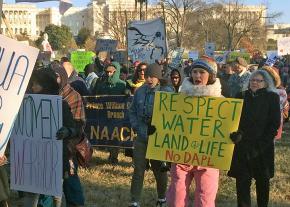The struggle doesn’t stop at Standing Rock
reports from Washington, D.C., on a rally that connected the fight against the Dakota Access Pipeline with a call to free political prisoner Leonard Peltier.
BENEATH THE flags of the American Indian Movement, Cherokee Nation and other First Nations, as many as 1,000 people came out in Washington, D.C., on December 10--International Human Rights Day--to show solidarity with the water protectors at Standing Rock by taking part in what was called "Standing Rock and Beyond Rally and March."
As an opening prayer and drumming welcomed residents from the D.C. area, contingents behind banners reading "Philly for Standing Rock," "West Virginia for Standing Rock" and "Veterans for Standing Rock" joined the growing rally that gathered just west of the Capitol Reflecting Pool.
"Free Leonard Peltier!" shouted Gabrielle Tayac, of the Piscataway Nation, as she kicked off the roster of speakers. Washington was the center of a week of events--including conferences, meetings, press conferences and vigils--calling for the release of one of the longest serving political prisoners in the United States.
Peltier, now 72, has spent more than 41 years as a federal prisoner for a crime he did not commit: the murder of two FBI agents on the Sioux Nation's Pine Ridge reservation in South Dakota in June 1975. Peltier's case serves as just one reminder that the U.S. government does not take seriously the sovereignty of Native nations within the United States.

The battle against the Dakota Access Pipeline on Lakota Sioux land in North Dakota is another in a long bloody history of genocide, as Tayac reminded her audience. "The ways of death started here," Tayac said, referencing again that the U.S. capital of Washington is located on land stolen from the indigenous Piscataway Nation.
"Our people have resisted for generation after generation. And now we feel a purifying wind from the North," Tayac continued. "Maybe it started at Standing Rock, but it is not stopping at Standing Rock."
Speaker after speaker took the stage with the U.S. Capitol dome as a backdrop, and a constant reminder of treaties made and treaties broken.
In the case of the Lakota Sioux and the Standing Rock Reservation, the treaties signed at Fort Laramie in 1851 and 1868 promised to the tribes the lands of the Black Hills, and around the Lower Brule, Cheyenne, Grand and Cannonball Rivers. However, these treaties were broken again and again with the discovery of gold, and the tribes lost land holdings in 1877, 1889 and 1910.
History appeared set to repeat itself, fueled by the greed for oil profits by the owners and shareholders of Energy Transfer Partners (ETP) and their Dakota Access Pipeline (DAPL) project, until the U.S. Army Corps of Engineers--under tremendous pressure from the growing movement in solidarity with the Standing Rock Sioux Tribe--announced it would deny ETP a permit to drill underneath the Missouri River.
DAPL--OR the "Black Snake" as many at Standing Rock refer to the pipeline in reference to a Lakota prophecy--would run 1,172 miles from the Bakken oil fields in North Dakota through South Dakota and Iowa, before ending in Illinois.
"The pipeline was supposed to run through Bismarck [the capital of North Dakota]," noted Jordan Marie Daniel, of the Kul Wicasa Oyate tribe of the Lakota nation. "But the town got together and voted 'No' because they were worried about contaminated drinking water. And the pipeline was rerouted, through treaty land."
"When the reroute happened," Daniel continued, "Standing Rock felt like their lives were expendable."
The rally was planned before the Army Corps announcement, but there was never any talk of canceling the protest because it is widely understood that the struggle against DAPL--and many other pipelines--will continue.
"Energy Transfer Partners had their day in court on Friday," said Daniel. "They have another court date in late January. President-elect Trump has already announced plans to okay the project as soon as he can. The fight is not over!"
Daniel then went on to repeat an appeal to action she made the previous Wednesday at a local meeting of the International Socialist Organization:
You need to call, write letters, stand in protest at every Army Corps of Engineers office across the country and here in D.C., divest from banks invested in DAPL, take five of your friends and video your divestment, and post it on social media with the hashtag #bankexit. The time is now to stand together for Standing Rock.
UNITY AND solidarity was a key theme from many of the speakers and represented by the multiracial crowd.
Juanita Cabrera Lopez, of the Maya Mam Nation, called on "people of all colors, all nations, Native and non-Native" to continue the fight against DAPL and well as other pipelines and poisonous priorities of profits, because we are "all one people."
"We stand as one people, without labels," said Gray Michael Parsons. "We have to be one, we have no choice." Parsons went on to relate how he had been active in the civil rights movement, and remembered how the mainstream media had showed the dogs and firehouses on television, bringing the battles into American living rooms.
"Today, they are doing the exact opposite," he said, calling out the major media outlets for all but ignoring the battle at Standing Rock and the militarized police presence mobilized to defend Energy Transfer Partner's illegal drilling under the Missouri River in North Dakota.
"The media is part of the marriage between the corporations and the U.S. government," Parsons said. "Therefore you have to be the media!" referring to the large impact that social media and independent media have played in getting out the word on the battle at Standing Rock. The audience, many of whom had visited Standing Rock themselves over the past few months, roared their assent.
Parsons warned of other pipeline projects set to disrupt sacred native lands, including the Atlantic Coast Pipeline and the Algonquin Pipeline. He concluded that we have to be proactive and begin the fight against these projects today.
The Zotigh Singers, of the Kiowa Nation, brought the rally to a close with a prayer song, which when translated into English, in part, means "Don't ever give up, there is another, better day coming."
THE MARCH from the Capitol to the Environmental Protection Agency was marked by symbolism and irony, as protests in Washington often are.
Union Square is at the western edge of the Capitol grounds and is also visible from the National Museum of the American Indian (NMAI). While the Capitol is a testament to broken treaties, and the statue of Gen. Ulysses S. Grant a reminder of the Indian Wars, the NMAI staff are repatriating hundreds of thousands of remains, funerary objects and cultural artifacts to tribes and families that had been looted by collectors and museums, including the Smithsonian.
As it happens, the stage for Trump's inauguration is being erected on the west side of the Capitol. Today's march followed a familiar path northwest along Pennsylvania Avenue. Marchers chanted, "Who do we Stand with? Standing Rock!" and "You can't drink oil, keep it in the soil!" as bystanders took pictures and waved or raised fists in solidarity.
As the march passed the Trump International Hotel at Pennsylvania Avenue and 12th Street, the chant changed to "We Stand! We Fight!"--a warning to the president-unelect that he will not have things all his own way after January 20.
The march ended at the Environmental Protection Agency (EPA) offices at 12th Street and Constitution Avenue, directly across 12th Street from the Trump Hotel.
Even before Trump nominated EPA-suing, climate-science-denier Scott Pruitt to head the agency, Indigenous peoples had no reason to put much faith in the EPA. The agency waited two days after the 2015 Gold King Mine Spill to alert the Navajo Nation of pollution in the Animas River, and a year later, the Navajo had still not been compensated for the loss of crops due to agency negligence.
Rally organizer Sebi Medina-Tayac was mindful of the coming Trump presidency and the legacy of U.S. genocide and colonialism as he closed the day by linking the fight at Standing Rock and the fights to come in the near future.
"We must recognize Standing Rock for the impact it has had on each of you. Standing Rock represents the world we want to build," Medina-Tayac said. "Standing Rock is about taking our power back."
THE MOST poignant moments of the rally came when Norman Patrick Brown, a survivor of the shootout at Pine Ridge, and Chauncey Peltier, Leonard's son, spoke to the audience.
Chauncey announced that his brother Wahacanka (Paul) Shields-Peltier had died in Washington, D.C., the day before. Wahacanka had been ill and on dialysis, yet insisted on visiting Standing Rock and then traveling to Washington for this week of activity around his father's compassionate clemency case.
"In true Oglala way, he said he wanted to go on this journey to help bring his father home," Chauncey wrote in a statement.
Chauncey then talked about the failing health of his father Leonard, and his fear that the Obama administration represents the last hope for Leonard's release. "If [his imprisonment] goes beyond January 19th, Leonard will die in prison," said Chauncey.
Brown spoke of how a younger Peltier stepped up to defend elders when the FBI and Bureau of Indian Affairs came to crush the American Indian Movement (AIM) in the mid-1970s.
Now as then, the U.S. government is lying and perverting justice to make an example of Peltier and to instill fear in others who might fight back. But as the encampments at Standing Rock enter their ninth month, this time, the government's tactics are failing. "Leonard wanted to say thank you to all the non-Indigenous people for their support," Brown said. "We have no enemies here. Our only enemy is corporate greed."




